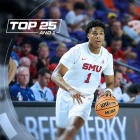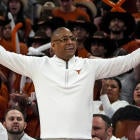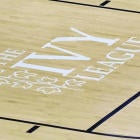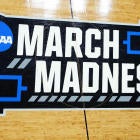
CBS Sports college basketball writers Gary Parrish and Matt Norlander surveyed more than 100 coaches for our annual Candid Coaches series. They polled everyone from head coaches at elite programs to assistants at some of the smallest Division I schools. In exchange for complete anonymity, the coaches provided unfiltered honesty about a number of topics in the sport. Over the next couple of weeks, we'll be posting the results on nine questions they were asked.
The next question in this series touches on a topic that, believe it or not, we've yet to address in the eight-year history of Candid Coaches: the NCAA Tournament selection committee.
The committee at large, its members, its methods and its decisions are a prime talking point, if not the primary talking point in sports, for about a week's time every March. In the past 10-12 years, the committee has indisputably evolved and gotten better at how it assembles and seeds the field of 68. But there's still plenty to work on, and creativity -- increased transparency, too, of course -- still awaits to be injected into the process.
The NCAA Tournament is the greatest event in American sports as far as I'm concerned. We lament the shortcomings because we care so much. So we handed the megaphone over to the coaches and asked them to voice the one thing they'd change, i.e. the one thing the selection committee most needs to fix.
What is your No. 1 issue with the NCAA Tournament selection process?
| Coach | Votes |
|---|---|
| Mid-major discrimination | 32% |
| Lack of consistency year-over-year/a clearer message on priority of criteria | 17% |
| Performance in league play should carry more weight | 17% |
| No issues/gripes | 10% |
| Use of the NET | 8% |
| More transparency from selection committee | 5% |
| Seeding protocol | 5% |
Quotes that stood out
On mid-major discrimination
- "When it comes down to mid-major teams and a team from a power conference, like a Clemson or UCLA the year they were an 11 seed, and the mid-major has won 25 games and didn't win their postseason tournament, you've got it between those two? You need to go to the mid-major. That is my biggest gripe. The little guys get snubbed 90% of the time. Murray State, Colorado State levels of schools. I was on one of the teams [bracketologists] picked all the way through the entire year ... and we were snubbed after not winning our league tournament."
- "High-major bias. It's hard for me to fathom none of Lipscomb, Greensboro or Furman getting in last year. The greatness of the tournament is that once the ball goes up anyone can win, these mid/low-major schools proved all year that they can compete with anyone, everyone is going to slip up in a league game."
- "If they are going to use the NET rankings as the main statistical driver, then the seeding and selection of those teams should reflect that. Case in point: the SoCon last year. Wofford under-seeded with a No. 13 in the NET, and a few other [highly rated mid-majors] being left out as at-large."
- "Dominant mid-majors that don't even get talked about as being on the bubble. Mids don't get enough Q1/Q2 games on their schedule -- especially when people know they are going to be good because no one wants to play them! A mid-major that wins 25 games but is 0-2 vs. Quad 1 is just as good as a high major program that is 2-8 vs Q1. But that is never reflected in the bracket."
- "Scheduling is incredibly different for us. We are trying to play anyone and everyone, and we can't get any games. We have been told no by essentially every high-major in the country with the exception of the ones we are playing. Makes it very difficult for a school like us to get an at-large bid. I'm not sure what the resolution is, but hope the committee looks at this. We simply don't have the opportunities regarding Quad 1 games."
- "As a mid-major assistant my biggest gripe is mid-major leagues getting one bid. They probably have to find a way to get regular-season champions into the NCAA Tournament. Can you imagine if Murray State didn't get in this last season? Before Mike White was at Florida he was at Louisiana Tech and they won the league on several occasions but didn't win the conference tournament. Those special teams he had never played in an NCAA Tournament."
On lack of consistency
- "I just want the goalposts to stop moving. The past three years it's been something different. Now it's the NET, now they're tweaking the NET, or are they? No one can schedule or game-plan, because then it's irrelevant within 18 months."
- "My biggest complaint is that while your numbers can be great (NET, RPI, etc.), the eye test, and beating a 'big name' school, will ultimately determine if they allow you in."
- "From year to year it changes and it's like they want to focus on different things. Are we going with the RPI, the NET, whatever it is. Being at a power-conference school, when I see some of those other schools work their way up there and played an awful conference schedule. Put Gonzaga in the ACC or Big Ten, they ain't going to be that 1 seed, in my opinion. It's easy to get up for one game, but when you're doing it on a nightly basis, it's little tougher."
- "Consistency: standards must remain the same year-in and year-out. I understand that new metrics come and go, but they need to be communicated well in advance as to best prepare teams for nonconference scheduling."
On the NET
- "There is zero transparency in the new NET rankings. Coaches don't know what you get rewarded for and what you don't."
- "I actually feel it's gotten better by using the NET. But the committee needs to know that good mids can't get teams to play them. If they do win a Quadrant 1 game, it should count five times more than if a high major wins one."
- "[My issue is] the consistency of the selection criteria. Even with the NET ranking, it still was vague. Will they place more emphasis on Quad 1 wins, more of an emphasis on Quad 4 losses, KenPom rankings -- more offense than defense or vice versa? Still doesn't factor in schools that have limited opportunity for Quad 1-2 wins, etc. All the while, where does nonconference strength of schedule [and] overall conference ranking fit in the criteria? What percentage of the equation will each factor in? Does it change depending on the committee? Endless questions that have not been answered."
- "NET rating must be adjusted. I do not believe that below-.500 teams in any league should play in the NCAA Tournament. High-majors have way more opportunities for Q1 and Q2 games than mid/low-majors. High-majors are purposely freezing mid/low-majors out in nonconference scheduling, and I understand why. Q1 and Q2 wins and losses are positive for them."
On in-league performance
- "I don't think that anybody can argue the point that momentum is a huge part of the game of basketball. With that being said, a team's full body of work is very important. However, I do not believe enough emphasis is placed on how well a team is playing (or poorly) down the stretch. When comparing bubble teams more weight should be put on the last two-to-three weeks of the season. Secondly, [power-conference] schools need to be rewarded in a significant way for going on the road. Neutral-court games are fine, but true road games are the most difficult to win. There is very little incentive for power programs to play true road games. Major conferences are now going to 20-game conference schedules. They are doing so to benefit themselves, not the game of college basketball as a whole."
- "There's too much stock in the nonconference [portion of your schedule]. Teams get better."
- "From what I've seen happen to friends in the business, where you finish in your league, it should have more impact than your strength of schedule or NET, because what you do in your league is who you really are. It's people who scout you very night, people who know your players front and back. You could have a great NET or RPI because you're a good scheduler. But how do you perform in your league? When Andy Enfield finished second in the Pac-12 (in 2018), played in the title game -- and Arizona State is getting in after finishing ninth in the Pac-12? I don't know how that can ever happen, ever, in any way."
- "If a team finishes below .500 in conference play you should not be able to qualify for the NCAA Tournament. Too many times a 27-win regular season champion mid-major team is left out in the cold for an 18-win power-conference team that played a majority of their nonconference games at home vs. guarantee opponents because they know they will have 16-plus opportunities in-conference play to get quality wins."
On transparency
- "My hope would be that the selection committee continues to be more open with the process. I think they have gotten better with this but I would like to see that transparency not just after the process is done but also prior to the season and leading up to Selection Sunday. Some of the new metrics may help that but I would like for them to be open and honest about what exactly they are going to look at and prioritize as they make their decisions of who is in and who is out. It's a tough job and I don't envy them one bit!"
On seeding
- "True seeding. 1-16. Fourth-best 1 seed should be in the same bracket as the fifth overall team, the top 2 seed. Fans and money should impact seeding less. NCAA championship should be more about true champion, not money."
On not having any issues
- "I think it is pretty fair. There are always teams on the bubble. Mid-majors argue that it is impossible to get an at-large bid. Bottom line is the programs that truly invest money in men's basketball give themselves a great opportunity to get in the tournament. I think it is a great tournament. Bottom line if you are in a multiple bid league -- WIN. If you are a mid-major, have a special year or win conference tourney. No matter what they do, there will always be a group of teams that can argue why they deserve to be in. That is why they call it the BUBBLE."
- "No gripes. Tired of people trying to gripe. Schedule hard and you'll never have to worry. NCAA has looked out for little guys that merit consideration in recent years. Fact is they don't have better players 95 percent of the time and aren't better than the teams that do make the tourney."
The takeaway
Now we're tapping into something coaches have a lot of opinions on and are very invested in. I wound up having to cut approximately another 20 impassioned quotes on topics you see above, in addition to critiques on: a lack of basketball people on the committee; tournament expansion; focusing more/paying more attention to injuries; and, how about this, the NCAA continuing to pay more for families to travel.
Here's what one coach told me.
"The NCAA should give families a stipend to attend NCAA tournament games, I think up to four guests, transportation, lodging, etc.," he said. "Why not? They just sent a bunch of average players all over the country to do chair shooting drills."
You know what? Fair point. Unquestionably extremely expensive, but perhaps more should be done. Currently, the NCAA "only" pays for parents/guardians of players who are in the Final Four.
Thankfully, expanding the tournament field beyond 68 teams isn't at the forefront of most coaches' minds. Only four coaches made that their priority, which I think is a good sign. The field was perfect at 64, is still great at 68 and absolutely, under no circumstances, needs more teams.
As for the lack of basketball people on the committee, it's a criticism the committee should take into account. The NCAA does its best to avoid biases, but there's no strong reason to not advocate for having a few true basketball minds involved and to take them out of the room when potential conflicts of interests arrive, the same way current athletic directors or conference commissioners must do when teams they're connected to are debated for inclusion and/or seeding.
As someone who's harped on some flaws with the seeding process, I was glad to hear some coaches voices real concern over that as well. On the whole, seeding seems to have gotten noticeably better in the past decade, but there's still some occasional inconsistencies -- and it's never sat well with me as committee chairs have casually said over the years how quickly seeding is accomplished on that Sunday of the bracket reveal. And as for transparency, I've long said/written that the committee and the NCAA could bring itself no better widespread publicity or praise than to draw the curtains and let us in on more of the process.
I disagree with the coaches who believe that in-league play should carry more weight, or that the final 10 games of a schedule should affect how teams are seeded. Those performances should be reflected to satisfactory outcomes within the NET, KenPom and other metrics the committee relies on. It's imperative to have nonconference play factor in for myriad reasons, but most importantly that November and December games carry real meaning, when college basketball is battling for national coverage.
And this ultimately all leads back to mid-major programs and the plight therein. If you're curious, no, not all the votes for mid-major discrimination came from mid-major coaches. Some came from coaches at big schools, guys who used to cut their teeth at the lower levels. Many coaches believe the selection committee and the process of building the field itself is not constructed to give top-shelf teams from the OVC, Sun Belt, MAC, Summit League, Ivy League, Big Sky, WAC, C-USA, you name it, the benefit of the doubt.
And with most big leagues going to 20-game intra-conference schedules, it stands to get worse than ever for teams in smaller conferences.
Here's the recent proof, which doubles as disquieting omen. Mid-major programs have, in the past half-decade, received very little love from the committee. For the practical purposes of this exercise, Gonzaga and Wichita State were not included for obvious reasons. Here's how many at-large bids were handed out to mid-major schools the previous five seasons:
2015: 5 (Boise State, BYU, Davidson, Dayton, San Diego State)
2016: 2 (Dayton, VCU)
2017: 3 (Dayton, Saint Mary's, VCU)
2018: 3 (Nevada, URI, St. Bonaventure)
2019: 3 (Belmont, Nevada, VCU)
And that's counting Dayton, VCU and BYU which, all in all, don't really operate like mid-major programs! The gripes against the committee's negative biases toward small schools are legitimate. The only school listed above truly from a one-bid league is Belmont. I mean, yikes. Now, opting to put Belmont in the bracket last March was refreshing to see, but schools like UNC Greensboro and Furman were, in my estimation, wrongly kept out. As the committee gets more comfortable with the NET and as coaches become more in tune with how it operates, it will be fascinating -- and pivotal -- to see how scheduling and committee behavior plays out in the coming years.
Twenty-game league schedules will not be disappearing from the Pac-12, SEC, Big Ten and ACC. The Big East will move to that model as well once UConn officially joins the conference in 2020. More league games converts to fewer spots on the slate in the nonconference, and when you factor in the exempt events and made-for-TV big-league-vs.-big-league challenges, mid-majors who float in that 40-100 range, who are expected to be good for their weight class in a given year, are getting fewer and fewer opportunities to play good teams.
The selection committee should rule as an arbiter in these cases. Big-league schools populate the big bracket too much as is. There is no downside, when essentially flipping a coin between a power-conference program and a mid-major, in choosing the mid-major a bit more often. The small-school upsets have provided more allure and appeal, on the whole, for the NCAA Tournament than anything else. I, and dozens of coaches who voted likewise in this poll, are not asking for overt reverse bias. We're asking for more perspective and acknowledgement of how good almost any team that wins 25-plus games is -- and why those teams from small leagues should be taken all the more seriously in spite of their lack of scheduling opportunities.
The class divide in college basketball was established decades ago, but 20-game league schedules figure to splinter the sport harsher than ever before. The selection committee is the only entity that can -- and should -- make up for that gap.
More Candid Coaches
- Who is the hardest coach to prepare for in college basketball?
- Which college basketball conference, top to bottom, has the best stable of coaches?
- Which school is the most underrated job in college basketball?
- Who was the best head-coaching hire in college basketball this year?
- Would your team visit Donald Trump in the White House if it won the national title?





















